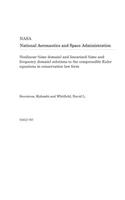
Nonlinear (Time Domain) and Linearized (Time and Frequency Domain) Solutions to the Compressible Euler Equations in Conservation Law Form
Series:
Two linearized solvers (time and frequency domain) based on a high resolution numerical scheme are presented. The basic approach is to linearize the flux vector by expressing it as a sum of a mean and a perturbation. This allows the governing equations to be maintained in conservation law form. A key difference between the time and frequency domain computations is that the frequency domain computa
NaN
VOLUME
English
Paperback

Two linearized solvers (time and frequency domain) based on a high resolution numerical scheme are presented. The basic approach is to linearize the flux vector by expressing it as a sum of a mean and a perturbation. This allows the governing equations to be maintained in conservation law form. A key difference between the time and frequency domain computations is that the frequency domain computations require only one grid block irrespective of the interblade phase angle for which the flow is being computed. As a result of this and due to the fact that the governing equations for this case are steady, frequency domain computations are substantially faster than the corresponding time domain computations. The linearized equations are used to compute flows in turbomachinery blade rows (cascades) arising due to blade vibrations. Numerical solutions are compared to linear theory (where available) and to numerical solutions of the nonlinear Euler equations. Sreenivas, Kidambi and Whitfield, David L. Unspecified Center NAG3-767...
Price Comparison [India]
In This Series
Bestseller Manga
Trending NEWS




















